Chic and Functional Modern Female Bedroom Ideas
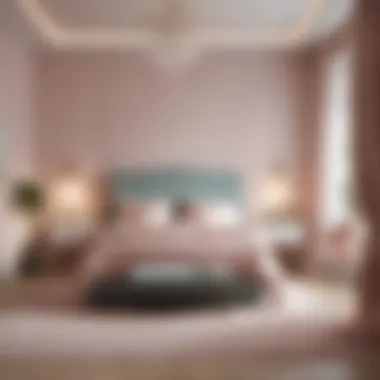

Intro
Creating a modern female bedroom involves mindful choices around color, furniture, and decor. The aim is to craft a setting that feels both inviting and empowering. This guide delves into various aspects of modern design, offering insights that cater to individual preferences and practical requirements.
Interior Design Tips
Trendy Design Ideas
Staying current with design trends can elevate a bedroom's ambiance. Some ideas worth exploring include:
- Sustainable Materials: Opt for furniture made from reclaimed wood or other eco-friendly materials to create a stylish yet responsible environment.
- Layered Textures: Combine different fabrics, such as velvet, linen, and knitted materials, to add depth and comfort to the space.
- Bold Accents: Incorporate bold accent pieces, like a striking bedspread or statement artwork, to create a focal point without overwhelming the room.
Color Schemes and Combinations
Choosing the right color palette is crucial. Modern bedrooms often feature a mix of soothing colors and vibrant highlights. Some popular schemes include:
- Soft Neutrals: Light grays, beiges, and whites can create a serene backdrop, allowing for accents in brighter shades.
- Pastel Hues: Colors like mint green and blush pink are in vogue, providing a fresh and feminine touch.
- Contrasting Tones: Pairing dark shades with bright colors can create a striking look. For instance, a navy blue wall with coral accents can deliver a modern edge.
Furniture Arrangement Techniques
Strategic furniture arrangement is pivotal for functionality. Consider the following techniques:
- Zoning: Define areas within the room. The sleeping area should feel separate from work or relaxation zones to enhance focus and tranquility.
- Balance and Symmetry: Use pairings, such as nightstands and lamps, on either side of the bed for a cohesive look.
- Functional Spacing: Ensure adequate space around furniture for ease of movement. A clutter-free environment promotes better mental clarity.
"Creating a modern female bedroom is not just about aesthetics but also about how the environment influences mood and well-being."
Inspirational Home Decor
Stylish Home Decor Pieces
Incorporating stylish decor enhances the overall aesthetic. Elements to consider include:
- Decorative Pillows: Choose varied patterns and textures to add both comfort and style.
- Throws: Soft, textured throws can help create a cozy atmosphere on beds or chairs.
- Unique Rugs: A striking rug can ground the space and add warmth, providing a clear visual anchor.
Wall Art and Prints
Wall decor plays a significant role in personal expression. Choose art that resonates with your personality:
- Framed Prints: Select a series of prints that reflect color harmony and personal interests.
- Personal Photographs: Create a gallery wall with photos encapsulating cherished memories.
- DIY Art: Crafting your own art pieces can add a unique touch while showcasing creativity.
Lighting and Ambiance
Lighting can drastically alter the feel of a bedroom. Consider different sources:
- Ambient Lighting: Soft overhead lights provide a general glow and create a relaxing environment.
- Task Lighting: Use bedside lamps or desk lamps for functional spaces. Adjustable lights can enhance usability.
- Accent Lighting: Incorporate fairy lights or LED strips to create an inviting, warm atmosphere, especially during evenings.
In summary, modern female bedrooms embrace individuality through thoughtful design. By integrating stylish decor, embracing trendy ideas, and optimizing space, one can create a haven that speaks to personal taste and enhances daily living.
Preamble to Modern Female Bedroom Design
Designing a bedroom is more than just placing furniture and selecting colors. It is an opportunity to create a personal retreat that reflects individual tastes and lifestyles. This is especially true for modern female bedroom design, where the intersection of aesthetics and functionality can significantly influence the quality of life for the inhabitant.
The bedroom serves multiple purposes: it is a sanctuary for rest, a workspace for creative endeavors, and sometimes even a small social hub. Therefore, every detail matters. From the color palette to the choice of furnishings and organizational strategies, each element contributes not only to the visual appeal but also to the overall atmosphere of comfort and usability.
Understanding the current trends in design can empower women to make informed choices that represent their unique personalities. Modern design recognizes the need for personalization, balancing current trends with timeless style.
Benefits of Modern Female Bedroom Design
Several key benefits emerge when focusing on modern bedroom design for women:
- Enhanced Comfort: A well-designed bedroom creates a cozy atmosphere conducive to relaxation and rest.
- Improved Functionality: Thoughtfully selected furniture can serve multiple purposes, addressing both space and storage needs effectively.
- Personal Expression: Modern design allows room for individuality, giving women the chance to craft a space that reflects their personal style.
- Increased Value: Aesthetically pleasing interiors can enhance the overall value of a home, making it appealing to potential buyers.
Considerations for Design Choices
While modern female bedrooms can be visually stunning, practical considerations must also be evaluated. Budget constraints, space limitations, and lifestyle requirements should not be overlooked during the design process. Furthermore, sustainability is a growing consideration, encouraging the use of eco-friendly materials thoughout the design process to promote environmental responsibility.
Key Principles of Bedroom Design
Designing a bedroom is about creating a space that serves both practical and aesthetic purposes. It’s not merely about placing a bed and some furniture; it involves a thoughtful approach that considers comfort, style, and the unique needs of the occupant. The key principles of bedroom design integrate these elements, helping to create a cohesive sanctuary that promotes relaxation and personal expression. In this section, we will highlight the importance of functionality and flow, as well as personalization, which together lay the foundation for an inviting bedroom environment.
Functionality and Flow
Functionality is central to any bedroom design. It ensures that the space is usable and meets the day-to-day needs of its occupant. Key factors to consider include the layout of furniture, access to key areas, and the flow of movement within the space. A well-planned room allows for easy navigation, minimizes clutter, and provides ample storage for personal items.
Some practical steps to enhance functionality include:
- Optimal Layout: Position the bed in a way that allows easy access while maximizing space.
- Incorporating Storage: Use under-bed storage or multi-functional furniture to keep items organized.
- Designated Areas: Define areas for sleeping, working, and relaxing.
Effective flow is about how these functional aspects interact with one another. The placement of furniture should foster a natural movement through the room. When designing, consider the pathways that will be taken daily and adjust accordingly.
Personalization Elements
Personalization is what transforms a generic bedroom into a cherished retreat. It involves integrating elements that reflect the occupant's individual style and personality. This can be achieved through color choices, decor items, and the incorporation of personal belongings. When a bedroom resonates with the individual's character, it becomes a place where they can truly unwind.
Important aspects of personalization include:
- Color and Texture: Choosing a color palette that feels harmonious and uplifting can directly influence mood and ambiance.
- Art and Accessories: Displaying artwork or objects that hold personal significance adds depth and character to the room.
- Sentimental Touches: Including family photos, travel memorabilia, or handmade items can make the space uniquely yours.
By focusing on functionality and personalization, the bedroom evolves into a more meaningful space. It is essential to prioritize these aspects in conjunction with contemporary design trends, ensuring that the end result is not just visually appealing but also aligned with the occupant's lifestyle and needs.
"A bedroom design should whisper serenity and style, a true reflection of those who dwell in it."
In summary, the key principles of bedroom design blend functionality and personalization. Understanding and applying these principles will lead to the creation of a sophisticated and comfortable haven.
Color Palettes for Modern Women’s Bedrooms
Choosing the right color palette is a fundamental aspect of designing a modern bedroom for women. Colors impact mood, perception, and even functionality of the space. A well-thought-out color scheme can enhance the beauty of a room and create a cohesive look that reflects personal style. Understanding the psychological effects of various colors and how they interact with light and space is crucial. Each color selection brings its own energy and atmosphere, allowing for a more tailored experience.
Neutral Tones
Neutral tones serve as an excellent foundation for modern female bedrooms. Colors like beige, gray, and soft whites create a calming background that promotes relaxation. These shades act as a canvas, enabling brighter accessories or furniture pieces to stand out without overwhelming the senses. Moreover, neutral palettes are versatile, allowing for easy updates with changing trends. Consistency across walls, bedding, and larger furniture contributes to a balanced aesthetic, making the room feel spacious and harmonious.
Benefits of using neutral tones include:
- Ease of Coordination: Neutral colors can seamlessly blend with various furniture styles and accessories.
- Simplicity: Neutral shades provide a minimalistic approach that suits many decorating themes.
- Timelessness: They remain fashionable, reducing the need for frequent redecorating.


Bold Accents
Incorporating bold accents adds character and depth to a bedroom. Deep blues, vibrant reds, or striking greens can elevate the space, allowing for personal expression. These colors can be introduced through statement pieces like a feature wall, decorative cushions, or artwork. The juxtaposition of bold hues against softer backgrounds brings life to the environment, making it both engaging and dynamic.
Key considerations for using bold accents include:
- Placement: Focus on specific areas, such as feature walls or accessories, for better visual impact.
- Balance: Ensure that bold colors do not overwhelm the space by balancing them with lighter tones or textures.
- Cohesion: Choose accent colors that complement the overall color scheme for a unified appearance.
Pastel Softness
Pastel colors can transform a modern bedroom into a sanctuary of serenity. Soft pinks, lavenders, and mint greens create a gentle ambiance that soothes the mind. These hues evoke femininity while maintaining a modern vibe. Pastel colors work well in layered textiles and decor, offering a soft contrast to more robust furniture pieces. They are particularly effective in small spaces as they tend to make rooms feel larger and airier.
Some advantages of pastel softness in bedroom design are:
- Softness: Pastels create a warm, inviting environment perfect for relaxation.
- Versatility: Easily paired with other colors for added dimension.
- Tranquility: Promote a peaceful atmosphere conducive to rest.
Effective color palettes not only enhance the visual appeal but also contribute to the overall functionality and mood of the space. Thoughtful selection of colors can elevate a bedroom beyond mere aesthetics.
Furniture Selection
Furniture selection plays a critical role in the overall design of a modern female bedroom. It is more than just a means to provide seating and storage; it is about creating a harmonious space that reflects personal style and fulfills practical needs. Each piece of furniture should contribute to both the aesthetics and functionality of the bedroom, ensuring that the environment is inviting and conducive to relaxation. The careful curation of furniture not only enhances the visual appeal but also influences the everyday experience one has in that space.
Essential Bedroom Furnishings
When discussing essential bedroom furnishings, it is important to consider the key pieces that are central to any functional bedroom layout. These typically include the bed, bedside tables, chest of drawers, and a desk or vanity.
- Bed: The bed is the focal point of any bedroom. Selecting the right size mattress and a stylish bed frame can significantly impact both comfort and aesthetics. Opt for designs that match the overarching theme, whether it's modern, minimalist, or eclectic.
- Bedside Tables: These small tables provide practical surfaces for lamps, books, and personal items. They should complement the bed in style and height, ensuring ease of access to essentials while reinforcing the overall decor theme.
- Storage Solutions: A stylish chest of drawers or a sleek wardrobe can help maintain order in the space. Look for pieces with smart storage capabilities that can blend seamlessly with other decor elements.
- Workspaces: If your bedroom doubles as a workspace, consider adding a small desk or vanity. It should be functional yet stylish, contributing to the overall design while providing necessary utility.
Multi-Functional Pieces
In today's fast-paced world, multi-functional furniture has gained prominence, especially in bedroom design. This innovation allows for maximizing space while keeping the room organized and stylish.
- Convertible Sofas: These are perfect for small bedrooms where a guest may need a place to sleep. They can serve as regular seating during the day and transform into a bed at night.
- Ottoman Storage: Use an ottoman not only for footrest but also as a storage unit. This helps in managing clutter effectively while providing additional seating options when required.
- Murphy Beds: For those with especially limited space, a Murphy bed can be a game-changer. It folds up against the wall when not in use, freeing up floor space for other activities.
- Desks with Shelving: Desks that incorporate shelving above them can save space and create an efficient workspace without overwhelming the room.
Selecting the right furniture is vital for establishing a balanced atmosphere in a modern female bedroom. It influences not just how the space looks, but also how comfortable and functional it is. Paying attention to both essential pieces and multi-functional items enables the creation of a space that meets both practical and aesthetic needs.
Lighting Options
Lighting plays a crucial role in any bedroom design. It influences mood, functionality, and the overall atmosphere of the space. For modern female bedrooms, consider the various lighting options available. Proper lighting can enhance the aesthetic appeal and increase how enjoyable the space is for relaxation, working, and socializing. A mixed approach to illumination will often yield the best results.
Layered Lighting Techniques
Layering lighting is essential in achieving balance and versatility in a bedroom. This method involves combining ambient, task, and accent lighting to address various needs and preferences.
- Ambient Lighting: This is the foundational lighting that illuminates the entire room. Ceiling fixtures, like flush mounts or chandeliers, are common choices. It sets the overall mood of the bedroom.
- Task Lighting: This type targets specific areas for activities such as reading or working. Table lamps on nightstands or wall-mounted sconces by the bed can ensure adequate light for these tasks. Choosing adjustable options allows for better flexibility.
- Accent Lighting: This highlights particular features or decor items in the room. Consider using wall sconces, track lighting, or LED strips to draw attention to artwork or plant arrangements. Accent lighting adds layers and visual interest.
In addition to the type of lighting, brightness can be adjusted using dimmers. This enhances versatility, allowing the user to adapt the room's ambiance according to their needs.
Decorative Light Fixtures
Decorative light fixtures serve not only to provide illumination but also to act as artistic elements in the bedroom. They can reflect personal style and enhance the overall decor theme.
- Chandeliers: A statement chandelier can serve as a focal point, adding elegance and sophistication to the bedroom. Many modern designs are sleek and minimalistic, fitting well in contemporary settings.
- Floor Lamps: Versatile and portable, floor lamps can be placed in various locations to create cozy corners. They come in styles ranging from modern to bohemian, allowing for personal expression.
- Pendant Lights: Hanging pendants can create a chic touch, especially over bedside tables or in reading nooks. They can be both stylish and functional, provided with the right bulb options.
- Wall Sconces: These fixtures not only save space but also offer a unique design element. They can be used to illuminate artwork or as reading lights, providing both practicality and style.
Using a combination of these decorative light fixtures can transform the ambiance of the bedroom. Proper placement and selection can yield a meaningful enhancement to the overall aesthetic of any modern female bedroom.
"Good lighting can change everything. It can elevate a space from simple to impactful."
By thoughtfully considering lighting options, one can create environments that are not just visually stunning but also comfortable and functional.
Textiles and Soft Furnishings
Textiles and soft furnishings play a crucial role in the design and comfort of modern female bedrooms. They contribute not only to the aesthetics but also significantly enhance the overall atmosphere and functionality of the space. Selecting the right materials can transform a room into a sanctuary that caters to personal tastes while ensuring warmth and comfort. Soft furnishings encompass a wide range of items, including bedding, cushions, rugs, and curtains, each serving a distinct purpose in the decor scheme. They can inject personality into the room, allowing for creativity and individual expression.
Choosing the right textiles involves considering various factors such as texture, durability, and ease of maintenance. Fabrics like cotton and linen are favored for their breathability and softness, while synthetic materials are often used for their durability and low maintenance needs. The right balance of these elements enhances not just the look but also the comfort and functionality of the bedroom.
Bedding Choices
Bedding choices are fundamental to both aesthetics and comfort in a bedroom. The bed is often the focal point in the room, making the selection of textiles like sheets, pillows, and comforters critical. Layers of bedding can be arranged to create a visually pleasing effect, while also providing flexibility for varying seasons. For instance, using lighter cotton sheets in summer while opting for thicker and warmer materials like flannel in winter allows adaptation to changing conditions.
Additionally, colors and patterns should align with the overall bedroom theme. Neutral tones such as whites and greys can create a calming atmosphere, while bold patterns can add a touch of vivacity. When choosing bedding, consider the following:
- Material: Prioritize breathability for comfort.
- Color Palette: Ensure it complements the room's overall design.
- Layering: Use multiple layers for depth and adaptability.
Curtains and Drapery
Curtains and drapery are vital elements that permeate the experience of a bedroom. They serve both practical and decorative functions. Functionally, they provide privacy and control light levels, which are essential for creating a restful environment. A well-chosen fabric can soften the light entering the room, contributing to a soothing ambiance.
From a design perspective, curtains can enhance the decor and elevate a space. Opting for longer drapes can create an illusion of height, making smaller rooms feel more expansive. Similarly, the right color and pattern can either contrast or blend with other elements in the room, creating a cohesive look.
When selecting curtains, keep in mind:
- Length and Weight: Longer and heavier fabrics often lend a more dramatic effect.
- Opacity: Sheer fabrics allow light while maintaining a level of privacy.
- Maintenance: Choose fabrics that are easy to clean to keep up their appearance.
Wall Treatments
The wall treatments in a bedroom significantly influence the overall atmosphere and aesthetics of the space. They serve not only a decorative purpose but also contribute to the functionality and mood of the room. Selecting appropriate wall treatments can enhance the dimensions of the space, offer sound insulation, and reflect personal style. Understanding the options available for wall treatments is essential for creating an inviting and personalized environment.
Paint Techniques
Paint techniques are among the most versatile options for wall treatments. They allow homeowners to express their creativity while maintaining a practical approach to design. Different finishes, such as matte, satin, or glossy, can affect how light interacts with the wall surface.
- Accent Walls: Creating an accent wall can add depth to a room. Choosing one wall to paint in a bold color while keeping the others neutral can create a focal point without overwhelming the space.
- Ombre Effects: This technique involves a gradual blending of colors, which can bring a sense of serenity and softness. It is excellent for creating a calming atmosphere, especially in a bedroom.
- Stenciling or Patterns: For those looking for something unique, stenciling can offer custom designs. Using geometric shapes or botanical patterns can infuse personality and flair into an otherwise plain wall.
"A well-painted wall is a work of art in itself, adding character and warmth to the space."
When deciding on paint colors, consider how they impact the room's perceived size and light. Light colors tend to make a space feel larger and airier, while darker shades can create an intimate ambiance but may require more light.
Wallpaper Trends
Wallpaper has made a strong resurgence in modern bedroom design. With advancements in technology, contemporary wallpapers offer more options than ever. They are not only stylish but also practical, as many are washable or made from eco-friendly materials.
- Natural Textures: Wallpapers that mimic natural materials, such as wood or stone, can create a rich, organic feel in a bedroom. These textures add warmth and can make the space feel more grounded.
- Bold Prints: Large-scale floral or graphic prints can serve as statement pieces. These designs can transform a bedroom into a chic retreat, allowing for bold expressions of individuality.
- Peel and Stick Options: For those who prefer flexibility, peel and stick wallpapers offer an easy way to change decor without commitment. They are ideal for renters or those seeking a temporary update.
When choosing wallpaper, consider its type, print scale, and colors. It is vital to select designs that resonate with personal taste while ensuring they complement other elements in the room.
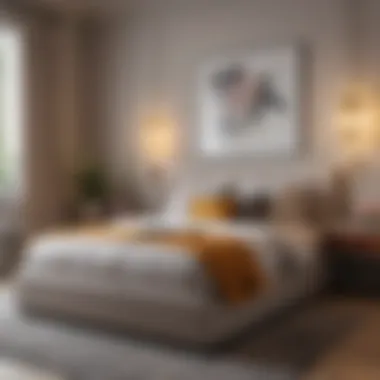
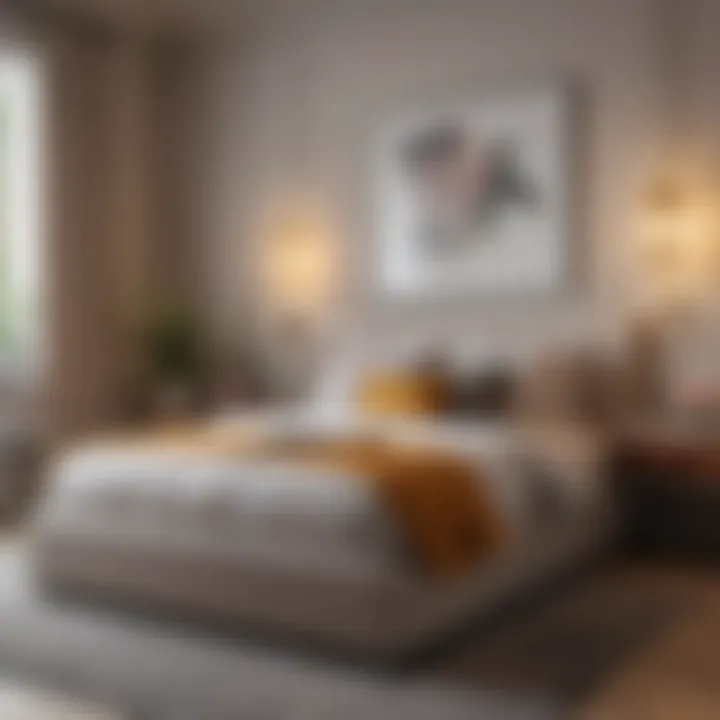
Artwork and écor
Artwork and decor are vital elements in creating a modern female bedroom that reflects personal style and enhances mood. They serve not only as visual focal points but also as expressions of identity and emotional wellbeing. Integrating art and decor invites creativity and inspiration, making the bedroom a more inviting and personalized space.
When selecting artwork, it is essential to consider the overall theme and color palette of the room. Art can influence the atmosphere significantly. For instance, large canvas paintings or framed prints can draw attention and add depth, while smaller pieces scattered throughout lend a feel of casual elegance. Choosing art that resonates personally is crucial—whether it be abstract pieces, photographs, or traditional paintings. This connection ensures a sense of comfort and authenticity in the space.
Moreover, art can invoke specific emotions. Calm and soothing colors may evoke relaxation, while vibrant colors can energize or uplift the mood. By thoughtfully arranging artwork, the space can achieve a balance that contributes to the overall harmonic design.
Personal Art Display
Creating a personal art display provides a unique opportunity to showcase individual taste and experience. Consider utilizing various methods for displaying art such as gallery wall setups or minimalist single pieces. Using different frame styles can enhance creativity, but coherence among the pieces is essential to avoid visual chaos.
Investing in display units like shelves or dedicated walls can provide versatile solutions. You may rotate your art collection to refresh the look periodically without major renovations. Personal photographs, art from local artists, or even DIY projects can all find a home in your bedroom, making the space truly your own.
Decorative Accessories
Decorative accessories are crucial for adding layers and texture which elevate the visual appeal of the room. Items such as vases, sculptures, or unique knickknacks can provide character and express unique choices.
When selecting accessories, think of how they complement and enhance the existing decor rather than overshadow it. Proper placement of these items can draw attention in a subtle yet strategic manner.
Integrate some functional elements as decoration as well. For example, a stylish basket can serve both as an accessory and a storage solution.
Thus, accessories are not mere additions; they are integral components of cohesive and inspiring decor. Keep in mind that less can be more. Avoid overcrowding surfaces with too many items, which can create disorganization and detract from the intended ambiance.
Indoor Plants and Greenery
Incorporating indoor plants and greenery into modern female bedroom designs is not just an aesthetic choice; it plays a significant role in enhancing the overall atmosphere of the space. Plants add life and energy to a room, creating a vibrant and inviting environment. Furthermore, they offer various health benefits, such as improving air quality, reducing stress, and fostering a connection to nature. For those seeking to create a sanctuary that promotes well-being, integrating greenery is essential. It acts as a natural filter that can help purify the air, offering a more healthy living space.
When selecting plants for a bedroom, consider factors like lighting, humidity, and personal care preferences, as some plants demand more attention than others. Native plants can thrive in certain conditions and are often easier to maintain. Prioritize your lifestyle when choosing the right species.
Best Plants for Bedroom Air Quality
Certain plants excel in purifying indoor air, which is ideal for bedrooms where people spend significant time resting and sleeping. Among the best choices are:
- Snake Plant (Sansevieria): Known for surviving in low light and requiring minimal water, this plant has the unique ability to convert carbon dioxide into oxygen at night.
- Peace Lily (Spathiphyllum): This beautiful flowering plant not only enhances decor but also absorbs harmful toxins like formaldehyde. It thrives in low to medium light.
- Spider Plant (Chlorophytum comosum): Very adaptable, spider plants can flourish in varied conditions and are effective at filtering pollutants.
- Aloe Vera: Apart from its healing properties, Aloe Vera releases oxygen at night, assisting in a better sleep cycle.
These plants are easy to care for and bring effective benefits to your bedroom's air quality. It's essential to consider if you have pets, as some plants can be toxic to animals, so keep that in mind when making selections.
Plant Arrangement Ideas
How you arrange plants can greatly influence the bedroom's overall feel. Below are some arrangement ideas that can beautifully enhance your space:
- Layered Heights: Use a combination of tall floor plants and smaller tabletop pots to create a dynamic display. This adds depth to the room.
- Group Similar Plants: Cluster plants with similar characteristics to create a cohesive look. Different shades of green can be striking when displayed together in varied-sized pots.
- Corner Displays: Corners often get ignored but can be turned into attractive focal points with larger plants like Fiddle Leaf Fig or Rubber Plant.
- Hanging Plants: Use macramé hangers to suspend trailing plants from the ceiling. This saves space and adds a vertical dimension to your decor.
Remember that plants need light. Place them where they'll receive adequate sunlight or consider using grow lights to ensure healthy growth.
In summary, adding indoor plants and greenery can dramatically improve both the aesthetic and air quality of a modern female bedroom. Thoughtful choices in plant selection and arrangement can transform a space into a serene and healthy retreat.
Storage Solutions
In the realm of modern female bedroom design, storage solutions hold a critical role. This aspect of interior organization not only addresses functional needs but also enhances the overall aesthetic of the space. As living spaces often trend smaller, the challenge is to create enough storage without sacrificing style. Good storage solutions allow for the decluttering of personal belongings, which in turn promotes a serene atmosphere.
Effective storage management can also reflect one’s personality. A well-organized bedroom exudes an image of tranquility and order, creating a welcoming and personal sanctuary. Moreover, with the right strategies, it is feasible to optimize every inch of space, giving rise to innovative designs that harmoniously blend functionality with visual appeal.
Under-Bed Storage Options
Utilizing the space under the bed is arguably one of the most practical strategies for making the most of a female bedroom. This area often goes unnoticed and underappreciated. By incorporating various storage solutions here, you can maximize the space you have. Some options include:
- Storage Bins: Clear plastic bins are an excellent choice, allowing visibility of contents. This helps in efficient organization and retrieval of seasonal clothing or extra bedding.
- Drawers on Wheels: These can slide easily under your bed. They can store anything from shoes to accessories, keeping them accessible yet out of sight.
- Bed Risers: Elevating the bed on risers can create more space for bins or boxes underneath. This is ideal for maximizing storage in smaller rooms.
Using under-bed storage not only maintains a tidy look but also showcases a penchant for practicality and smart design.
Creative Closet Organization
Closets can quickly become chaotic zones, making creative organization essential in modern female bedrooms. Here are a few ideas to enhance closet efficiency:
- Multi-Tier Hangers: These diversely hung racks can hold multiple items in a vertical space. They minimize the clutter that can accumulate with regular hangers.
- Color-Coding: Arranging clothing by color can not only simplify choices but also creates a visually appealing system. This adds a decorative touch to mundane organization.
- Shelf Dividers: These are invaluable for managing stacks of clothing. They prevent piles from toppling and ensure everything is displayed neatly.
- Hooks and Pegboards: Installing hooks on the interior of the closet door can hold accessories, bags, or jewelry. Pegboards can serve a similar function, allowing for creative organization of personal items.
Implementing these strategies can create a streamlined and multifunctional closet space. It not only reflects order but also caters to the aesthetic preferences of the owner.
Technology Integration
Technology plays a pivotal role in modern bedroom design, especially for women who seek both style and functionality. Integrating technology into a bedroom can enhance the overall experience. Factors like convenience, comfort, and personalization should be key considerations when including technology.
Using technology can simplify daily tasks and improve the ambiance. For instance, smart home devices allow for seamless control of lighting, temperature, and entertainment systems. These integrations help create a tailored environment that meets personal needs. Additionally, technology can also promote relaxation, as various products can assist in creating a soothing atmosphere conducive to rest.
While integrating technology, it is also important to consider aesthetics. Devices should complement the bedroom design rather than detract from it. Well-designed products, such as sleek sound systems or minimalist smart bulbs, can blend seamlessly into the decor.
Smart Lighting Solutions
Smart lighting is becoming an essential feature in modern female bedrooms. These systems offer options beyond the traditional switch. One significant advantage of smart lighting is the ability to customize settings. Users can adjust brightness, color temperature, and even create lighting scenes. This flexibility enhances mood and can support activities ranging from reading to meditating.
Here are some options to consider for smart lighting:
- Smart LED Bulbs: These bulbs can change colors and are adjustable to different brightness levels.
- Smart Light Strips: Ideal for adding accent lighting under furniture or shelves, providing a modern touch.
- Touch or Voice Control: Many smart lighting systems allow users to manage settings using mobile apps or voice commands.
"Smart lighting not only enhances ambiance but also maximizes energy efficiency."
Comfort and convenience are other benefits. For example, smart lighting can be programmed to gradually brighten in the morning, simulating a natural sunrise. This feature can positively impact the body's circadian rhythm, promoting better sleep quality.
Entertainment Systems
Entertainment systems in the bedroom, tailored to personal preferences, enhance relaxation and enjoyment. The evolution of technology has made it easier to integrate high-quality audio and visual solutions without compromising space.
Considerations when selecting an entertainment system include:
- TV Size and Placement: A wall-mounted TV can save space and avoid clutter.
- Audio Quality: Wireless sound systems or soundbars can provide superior quality without bulky equipment.
- Streaming Options: Services like Netflix or Spotify offer vast entertainment choices, easily accessible through smart devices.
By combining aesthetics with functionality, an entertainment system can transform the bedroom into a personal cinema or concert hall. Careful selection of technology not only elevates the room's design but creates a personalized space for relaxation and entertainment.
Creating a Relaxation Zone
Creating a relaxation zone in a modern female bedroom is essential to ensure that the space serves as a personal refuge from the demands of daily life. This aspect of bedroom design focuses on fostering tranquility and comfort. A well-designed relaxation area can improve mental clarity and encourage a sense of well-being. By incorporating specific elements aimed at relaxation, one can transform the bedroom into a sanctuary that nurtures physical and emotional health.
The benefits of having a dedicated relaxation space are numerous. It provides an inviting corner where one can unwind after a long day, read a book, or enjoy quiet contemplation. This can be especially valuable in today’s fast-paced world, where stress often takes a toll on health. Apart from physical benefits, creating such spaces also allows for personalization and expression of individual style, making the environment more appealing.
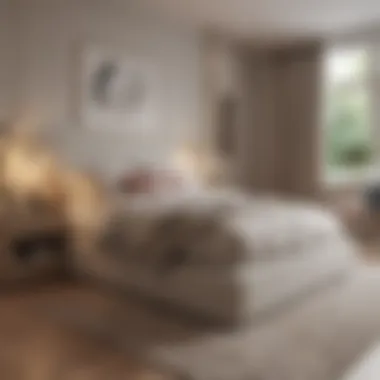
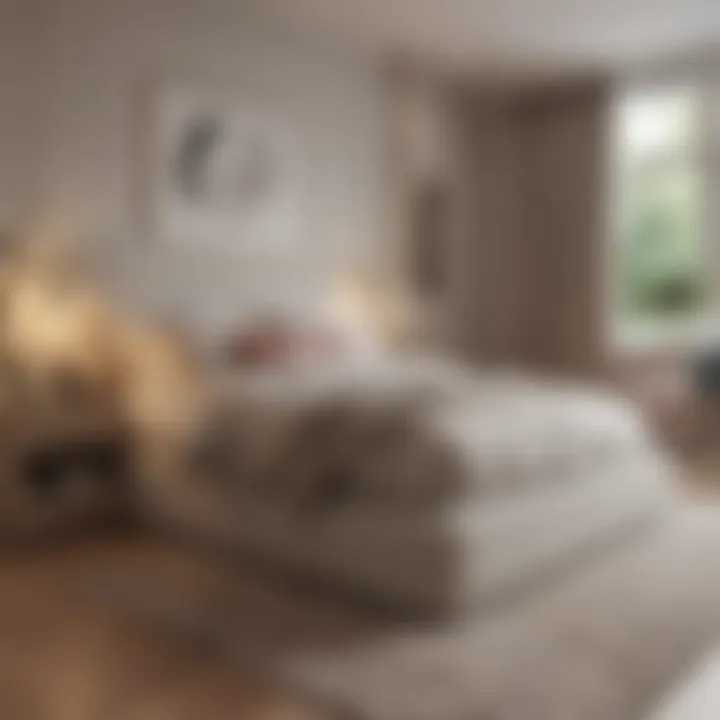
When designing a relaxation zone, several considerations should be kept in mind to maximize its effectiveness. The choice of furniture, lighting, and textures plays a crucial role. Soft textiles, comfortable seating, and appropriate lighting can create a welcoming atmosphere. Additionally, the location of this space within the bedroom should be strategically planned to avoid disturbances and enhance its calming effects.
"A well-defined relaxation zone can significantly enhance the overall ambiance of a bedroom, allowing for moments of peace and serenity."
Reading Nooks
Integrating a reading nook into a bedroom is one of the most practical methods to create a relaxation zone. Reading nooks can be tailored in numerous ways, depending on the available space. The focus here is on cultivating a space that is cozy and inviting. A comfortable armchair, soft throw blankets, and a small table for books or refreshments can elevate this area significantly.
When selecting the location for a reading nook, consider positioning it near natural light sources, such as windows. Natural light has proven benefits for well-being and can enhance the experience of reading. Soft, soothing colors on walls and surrounding decor can also add to the relaxed ambiance.
In terms of decor, personal touches can be integrated. Shelves filled with favorite books, framed pictures, or artwork create a unique space that reflects personal interests. The overall aim is to foster a sense of comfort that invites spending time in this nook, ideally promoting reading habits or simply enjoying quiet moments.
Meditation Spaces
Creating a meditate space within the bedroom is another vital element in the relaxation zone. This area should promote inner peace and mindfulness, serving as a retreat for reflection and rejuvenation. The design should emphasize simplicity and minimalism to promote clarity and calm.
A meditation space does not require elaborate setups. A comfortable mat or cushion can be sufficient; some may prefer a low chair if sitting cross-legged is not comfortable. Soft, ambient lighting is essential. This could range from dimmable lamps to candles. Many individuals find that calming colors, such as muted blues or greens, enhance their meditation practices.
It is also beneficial to consider incorporating elements of nature. Small indoor plants or natural materials can create a soothing atmosphere. This aligns with the notion that nature has a grounding effect on location.
To sum up, both reading nooks and meditation spaces greatly contribute to the creation of a relaxation zone. They help in developing a personal sanctuary that supports mental well-being and elegance while providing a haven to recharge from life’s demands.
Maintaining Balance and Harmony
Maintaining balance and harmony in a bedroom is essential for creating an inviting and rejuvenating space. A well-balanced room promotes relaxation, enhances focus, and contributes significantly to overall well-being. Harmony in design means that all elements—colors, furniture, lighting, and decorations—should work together to create a cohesive environment. This concept affects the emotional response one has to the space, making it not just a place to sleep, but a sanctuary for personal expression and comfort.
Consideration must be given to each aspect of the design process. For example, when choosing a color palette, it is crucial to select shades that complement each other rather than clash. Additionally, the arrangement of furniture should allow for easy movement, preventing overcrowding and ensuring a sense of flow throughout the room.
"A harmonious environment fosters a productive state of mind, supporting both rest and creativity."
Key elements that contribute to maintaining balance include:
- Proportion and Scale: Ensure that furniture sizes are appropriate for the room’s dimensions. Oversized pieces can overwhelm, while too-small furnishings can feel lost.
- Symmetry and Asymmetry: Symmetrical arrangements often promote calmness. Asymmetry can add visual interest but must be done thoughtfully.
- Color Distribution: Balance dark and light tones throughout the room to prevent feelings of heaviness or starkness.
By employing these practices, a bedroom can truly reflect individual style while providing a peaceful retreat.
Decluttering Techniques
Decluttering is more than just removing unnecessary items; it is about creating an atmosphere that encourages clarity and peace. Effective decluttering can lead to reduced stress and enhanced focus. Begin by assessing the room and identifying what is essential. A practical approach includes sorting items into categories: keep, donate, and discard.
- Go Room by Room: Start with one area at a time to avoid feeling overwhelmed. Focus on surfaces first, such as nightstands and dressers.
- Storage Solutions: Use bins or organizers to contain smaller items. This promotes a cleaner look and makes it easier to find what you need.
- Regular Reviews: Establish a routine for periodically reviewing belongings to ensure that clutter does not accumulate again.
Promoting Serenity Through Design
Serenity in a bedroom contributes to its primary purpose: a place to relax and recharge. Strategic design choices can create a calming atmosphere.
- Natural Materials: Incorporate wood, cotton, or linen into decor. These materials add warmth and clarity to a space.
- Soft Textures: Use soft furnishings such as throws or plush pillows to provide comfort and coziness.
- Aromatic Elements: Consider using scents such as lavender or eucalyptus through candles or diffusers. Scent has a profound impact on mood
A serene environment also encourages mindfulness and mental balance. Engage with your space in a way that promotes peace, and the positive impact on daily life will be evident.
Sustainable Design Practices
In today's world, sustainable design practices have become increasingly vital, especially in the context of creating a modern female bedroom. These practices not only enhance the aesthetic appeal but also encourage an environment that respects nature and promotes well-being. By understanding the value of sustainability, individuals can create spaces that are not only beautiful but also responsible and ethical.
Focusing on sustainable design means considering various elements, such as material selection, energy efficiency, and the lifecycle of products used in the bedroom. Implementing eco-friendly materials enhances the overall ambiance while reducing the carbon footprint. Additionally, making informed choices about lighting, furniture, and decorative accessories can lead to significant long-term benefits for both the individual and the environment.
Choosing Eco-Friendly Materials
When selecting materials for a modern female bedroom, eco-friendly options play a crucial role. Products made from sustainable sources, like bamboo, reclaimed wood, or recycled metals, are excellent choices. These materials have a lower impact on the environment and often ensure longer-lasting quality.
Considerations include:
- Certifications: Look for furnishings marked with certifications such as Forest Stewardship Council (FSC) to ensure responsible sourcing.
- Natural Fibers: Opt for bedding and textiles made from organic cotton, linen, or hemp. These fibers are not only biodegradable but often free from harmful chemicals.
- Low VOCs: Choose paints and finishes that have low volatile organic compounds (VOCs) to improve air quality within the bedroom.
Employing eco-friendly materials fosters a healthier lifestyle while minimizing the negative impact on the planet.
Upcycling Ideas for Furniture
Upcycling is an innovative approach to repurposing old or discarded furniture into unique pieces that fit seamlessly into a modern female bedroom. This practice not only extends the life of furniture but also adds character and personal touch to the space.
Here are some practical ideas to consider:
- Refurbished Nightstands: Transform an old wooden nightstand with a fresh coat of paint, or change the drawer pulls to breathe new life into it.
- Reimagined Dresser: Use wallpaper or fabric to cover dresser drawers, adding a pop of color or texture.
- Vintage Accent Pieces: Hunt for vintage tables or chairs at thrift stores and give them a new finish or upholstery that aligns with your design vision.
By upcycling, individuals create a distinct aesthetic while supporting sustainability efforts. This practice not only aligns with modern trends but also helps reduce waste in landfills.
"Sustainable design practices contribute to a harmonious relationship between personal style and environmental stewardship."
The Future of Bedroom Design for Women
As we progress into an era that places high value on individuality, the future of bedroom design for women reflects this societal shift. The importance of this topic lies in its potential to adapt to changing lifestyles and preferences. A bedroom is not only a place for sleep; it serves multiple functions, including work, relaxation, and creativity. Thus, the design must encompass aspects that cater to these various needs.
Recent trends indicate that women are seeking to create spaces that mirror personal storytelling and influence their well-being. Consequently, incorporating elements that promote comfort and functionality becomes crucial. Designing a bedroom is now more about creating a sanctuary where personal identity is expressed, rather than adhering to strict decor rules.
In this exploration, several critical elements emerge that shape future bedroom designs:
- Sustainability: Environmental consciousness is rising. Many women prefer eco-friendly materials and practices, valuing products that are not harmful to the planet.
- Customization: As tastes evolve, the desire for personalized spaces grows. This leads to a focus on bespoke designs that reflect individual preferences.
- Wellness: The integration of wellness elements into design raises the bar for a tranquil environment. This involves careful consideration of layouts, lighting, and soundscapes.
Recognizing these considerations is paramount for designers. Such awareness enables the creation of adaptable environments that respond to women’s diverse lifestyles today and in the future.
Emerging Trends to Watch
The landscape of bedroom design is rapidly evolving. Key emerging trends offer insight into how women's bedrooms will transform:
- Biophilic Design: This trend emphasizes connecting with nature. Incorporating natural light, plants, and organic materials becomes essential in creating a restorative environment.
- Smart Furniture: Innovative items that serve multiple functions and adapt to different needs are gaining popularity. Pieces like convertible sofas or beds with built-in storage are appealing.
- Mood Enhancing Features: Ambient lighting, sound control, and temperature regulation systems are becoming standard as they directly influence comfort levels and relaxation.
- Mixing Styles: Individuality drives a shift toward eclectic designs that combine various styles like minimalism with bohemian or vintage elements.
Understanding these trends prepares homeowners and designers for the future landscape of bedroom aesthetics.
Influence of Technology on Design Choices
Technology's role in design cannot be overstated. The influence is especially pronounced in bedrooms, an intimate space that benefits from technological accessibility and efficiency. Here are key aspects to consider:
- Smart Home Integration: The rise of smart homes means that bedroom designs increasingly incorporate devices like smart lights, thermostats, and security features, allowing homeowners to control their environments easily.
- Virtual Reality: This technology opens opportunities for immersive design experiences. Homeowners can visualize changes in their spaces, helping them make more informed decisions before committing to designs.
- Online Tools: A plethora of online platforms and applications assist in virtually styling spaces. Tools that offer color matching and layout design streamline planning and reduce the stress that can accompany remodeling.
The End
In the realm of modern female bedroom design, the conclusion serves as a crucial wrap-up to the myriad concepts and ideas explored throughout the article. It synthesizes key elements that underscore the effectiveness of well-considered design. A harmonious bedroom environment not only showcases personal style, but also caters to functionality and comfort. This synthesis emphasizes that designing a bedroom is not merely about aesthetics; it involves creating a sanctuary that supports well-being and promotes relaxation.
The benefits of incorporating these modern elements are profound. For example, when choosing color palettes, a thoughtful selection can influence mood. Neutral tones provide a calming effect, while bold accents can energize a space. Understanding this interplay of colors is fundamental as it encourages mindfulness in choices that affect daily life.
Furthermore, the consideration of sustainable practices has gained weight in recent years. By opting for eco-friendly materials and upcycling furniture, individuals contribute to broader environmental goals while enriching their personal space. This aspect not only reflects conscientious living but also adds depth to the bedroom's narrative.
When reflecting on organization, the solutions discussed throughout the article highlight how a clutter-free environment enhances mental clarity. Storage solutions need careful planning, allowing homeowners to balance aesthetics with functionality.







